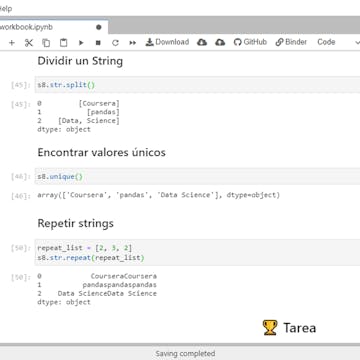
Good to know
Save this course
Reviews summary
Beginner-friendly pandas intro
Activities
Python Refresher
Show steps
Strengthen your Python foundation to ensure a smooth transition into the Pandas course.
Browse courses on
Python Basics
Show steps
-
Review basic Python syntax and data types.
-
Practice writing simple Python programs.
-
Complete online tutorials or exercises on Python fundamentals.
Jupyter Notebook Experimentation
Show steps
Become familiar with Jupyter Notebooks and develop your data exploration skills by experimenting with different datasets.
Browse courses on
Jupyter Notebooks
Show steps
-
Create a new Jupyter Notebook.
-
Load and explore various datasets using Pandas.
-
Visualize the data using Matplotlib or Seaborn.
-
Save and share your notebook with peers or instructors for feedback.
Pandas Study Group
Show steps
Enhance your understanding and application of Pandas concepts through collaborative learning with peers.
Show steps
-
Form a study group with 2-3 classmates.
-
Meet regularly to discuss course materials, solve problems, and share insights.
-
Work together on a small Pandas project or analysis.
Two other activities
Expand to see all activities and additional details
Show all five activities
Intermediate Pandas Tutorial
Show steps
Enhance your proficiency in Pandas by following an online tutorial that covers advanced techniques and best practices.
Show steps
-
Enroll in an intermediate Pandas tutorial on Coursera, Udemy, or edX.
-
Complete the tutorial videos and exercises thoroughly.
Kaggle Pandas Competition
Show steps
Challenge yourself and apply your Pandas skills in a competitive environment by participating in a Kaggle competition.
Show steps
-
Identify a suitable Kaggle competition that involves Pandas usage.
-
Download the competition dataset and explore it.
-
Develop a Pandas-based solution to the competition problem.
-
Submit your solution and track your progress on the leaderboard.
Python Refresher
Show steps
Strengthen your Python foundation to ensure a smooth transition into the Pandas course.
Browse courses on
Python Basics
Show steps
- Review basic Python syntax and data types.
- Practice writing simple Python programs.
- Complete online tutorials or exercises on Python fundamentals.
Jupyter Notebook Experimentation
Show steps
Become familiar with Jupyter Notebooks and develop your data exploration skills by experimenting with different datasets.
Browse courses on
Jupyter Notebooks
Show steps
- Create a new Jupyter Notebook.
- Load and explore various datasets using Pandas.
- Visualize the data using Matplotlib or Seaborn.
- Save and share your notebook with peers or instructors for feedback.
Pandas Study Group
Show steps
Enhance your understanding and application of Pandas concepts through collaborative learning with peers.
Show steps
- Form a study group with 2-3 classmates.
- Meet regularly to discuss course materials, solve problems, and share insights.
- Work together on a small Pandas project or analysis.
Intermediate Pandas Tutorial
Show steps
Enhance your proficiency in Pandas by following an online tutorial that covers advanced techniques and best practices.
Show steps
- Enroll in an intermediate Pandas tutorial on Coursera, Udemy, or edX.
- Complete the tutorial videos and exercises thoroughly.
Kaggle Pandas Competition
Show steps
Challenge yourself and apply your Pandas skills in a competitive environment by participating in a Kaggle competition.
Show steps
- Identify a suitable Kaggle competition that involves Pandas usage.
- Download the competition dataset and explore it.
- Develop a Pandas-based solution to the competition problem.
- Submit your solution and track your progress on the leaderboard.
Career center
Data Scientist
Machine Learning Engineer
Statistician
Data Visualization Specialist
Operations Research Analyst
Data Engineer
Market Researcher
Data Journalist
Quantitative Analyst
Business Analyst
Financial Analyst
Epidemiologist
Biostatistician
Software Engineer
Data Analyst
Reading list
Share
Similar courses
OpenCourser helps millions of learners each year. People visit us to learn workspace skills, ace their exams, and nurture their curiosity.
Our extensive catalog contains over 50,000 courses and twice as many books. Browse by search, by topic, or even by career interests. We'll match you to the right resources quickly.
Find this site helpful? Tell a friend about us.
We're supported by our community of learners. When you purchase or subscribe to courses and programs or purchase books, we may earn a commission from our partners.
Your purchases help us maintain our catalog and keep our servers humming without ads.
Thank you for supporting OpenCourser.



